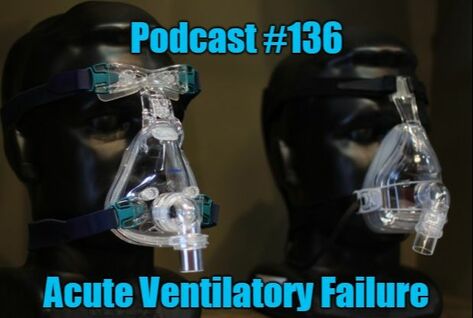|
Sam Ireland is back to talk again about ventilatory failure. Last time, he talked about the less severe impending ventilatory failure but this time he runs us through acute ventilatory failure. If you have not already checked it out, look at our last post for details on impending ventilatory failure.
For this post we talk about acute ventilatory failure which Sam breaks down as a definition and the management of the condition. Here are the key points, but please listen to the podcast for full details.
Definition: These patients generally started as impending ventilatory patients (see last post) and either were not treated correctly prior to this point or there was a significant delay in their care for some reason. They are in respiratory distress with a low minute volume, low respiratory rate, low tidal volume (not a lot to work with - they are barely breathing), and this is when the PCO2 of >50 starts to impact the pH with the pH probably <7.30 (uncompensated respiratory acidosis). On top of being uncompensated, they are tired now so they are not even trying. Management: These patients basically need a BVM, since in a traditional BiPAP mode you set a rate. You may be tempted to intubate, but this can actually make the situation worse especially with significant acidosis as this can lead to cardiac arrest. You need to RTI - Resuscitate Then Intubate. A lot of people will try bag these patients, but fail for issues such as failing to recognize the COFFIN position ("Cannot Oxygenate Face Flat In Neutral Position"). Instead, these patients should be sitting upright or at least with the head elevated. This can also in some ways help with better ventilation prior to intubation (if it is still needed). Better Options : 1. ‘BVM’ mode on the ventilator (NPPV Pressure, AC/PC, SIMV Pressure) through NPPV mask 2. CPAP / BiPAP mask with nasal cannula under at high-flow, BVM with PEEP valve attached. If the patient can bag themselves, there may be a possible role, but listen to the podcast for details. As a side note, make sure you understand the anatomy of a BVM which Sam did a great job discussing on the FOAMfrat podcast. Still want to understand Bi-level ventilation (as we used short-hand BiPAP above) better? Sam has a podcast on that, too! His friend, Tyler Christifulli, has a podcast on optimizing PEEP and an interview with Josh Dillman on NPPV tips. Check them out and master these skills. Finally, Sam mentioned the Flow-Safe II which is a potential alternative to traditional bilevel system as does not require the specific bilevel ventilator. Sam has no conflict of interest with this company. Let us know what you think by giving us feedback here in the comments section or contacting us on Twitter or Facebook. Remember to look us up on Libsyn and on iTunes. If you have any questions you can also comment below, email at [email protected], or send a message from the page. We hope to talk to everyone again soon. Until then, continue to provide total care everywhere.
1 Comment
Anne Castioni
4/20/2019 01:12:48 pm
This was great! Plenty of excellent ideas about managing the airway and improvising in the field.
Reply
Leave a Reply. |
Libsyn and iTunesWe are now on Libsyn and iTunes for your listening pleasure! Archives
August 2022
Categories |
||||||


 RSS Feed
RSS Feed